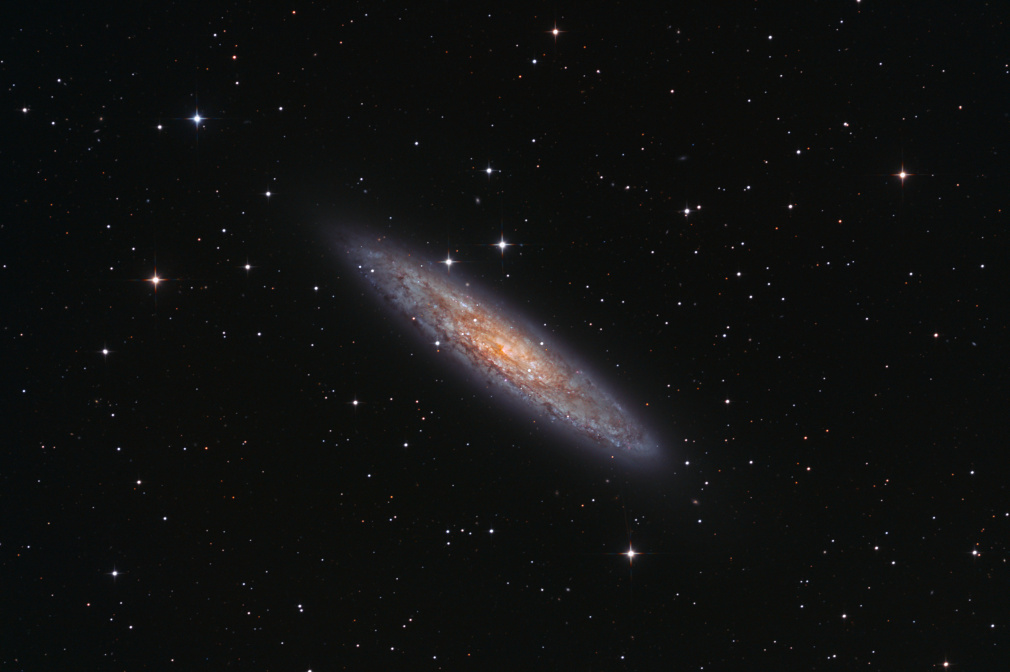The famous galaxy in constellation Sculptor is called The Silver Dollar Galaxy, but it is also known as The Sculptor Galaxy. It is the third brightest galaxy in the sky after the Milky Way and the Andromeda Galaxy.
It was discovered by Caroline Herschel in 1783 during her hunt for comets. In the NGC catalogue published in 1888, The Silver Dollar Galaxy got the ID 253. It is an easy to observe object even with a pair of binoculars or a small telescope because of its large apparent size and brightness. The longer axis of the galaxy is 28', which is approximately the diameter of the full Moon. Its distance is only11.5 million light-years which is considered quite close among galaxies. The real diameter is approximately 70 thousand light-years, about 30-40% smaller than our galaxy the Milky Way.
Like all spiral galaxies, the Silver Dollar Galaxy has a super massive black hole at its centre. The mass of the black hole is approximated about 5 million solar masses. NGC 253 is classified as SAB(s)c in the de Vaucouleurs classification system. In the system SA designates normal spiral galaxies, SB is used for barred spiral galaxies and SAB is assigned to a special type of galaxies in between the other two types, the intermediate spiral galaxies. According to current understanding bars in spiral galaxies are temporary only structures. In the early phases of galaxy evolution bars transport gases necessary for star formation from the outer regions to the core. Later they decay, and the galaxies become normal spiral galaxies without bars. The Sculptor Galaxy is classified as an intermediate spiral galaxy, which means decomposition of its bars is already in progress. Messier 83 galaxy introduced earlier on this site has also classified as SAB(s)c, which means the two galaxies have very similar structure, but while disc of M83 is seen almost right above, the viewing angle of NGC 253 is much less.
The central bulge of NGC 253 contains old stars mainly, so its colour is yellowish-reddish, while the continuous star formation taking place in the disc producing a lot of young stars, whose strong blue light makes the outer region of the spiral arms blue.
Due to the high rate of star formation in the Silver Dollar Galaxy both in the past and at the present, NGC 253 is categorised as a starburst galaxy too. Intense star formation created several super star clusters (SSCs) in the galaxy. SSCs are clusters containing a very large number of hot, young stars. They are thought to be the predecessors of globular clusters. Many of the SSCs' members are Wolf-Rayet stars, which are massive hot giant stars (having more than 20 solar masses). These stars emit very strong stellar winds reaching up to 2000km/s radial velocity. These winds combined, including the shockwaves of supernovae blows the interstellar gases out from the disc into the halo of the galaxy. This is phenomena is called the galactic superwind, and can be observed in the image too, in the form of dark column-like outflows perpendicular to the plane of the galaxy.
According to commonly accepted theories current wave of star formation in NGC 253 was triggered by a collision with a dwarf galaxy rich in gases, about 200 million years ago. Plenty of signs justify this theory, including the high amount of neutral hydrogen and high number of young stars in the halo of the galaxy.
Because fuel of star formation escapes the galaxy by the intense outflow of gases, it is very likely the rate of star formation to be decreased in the galaxy in the future.
